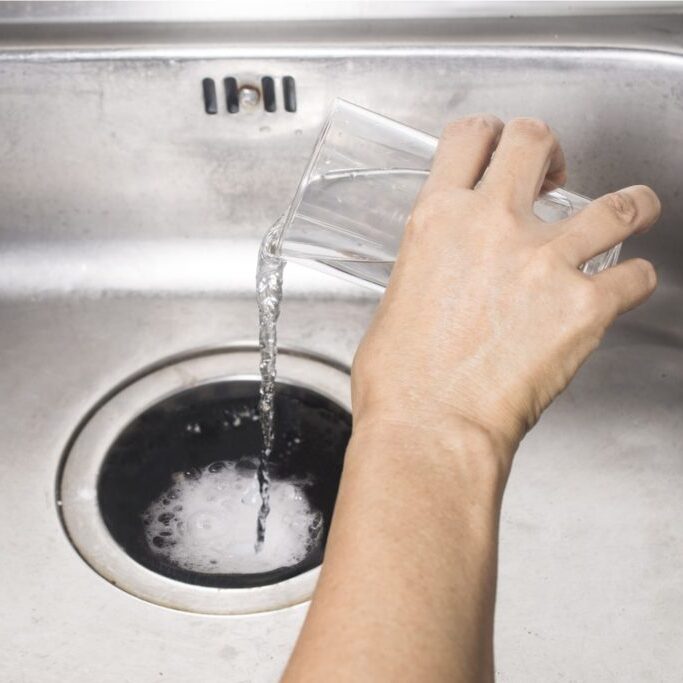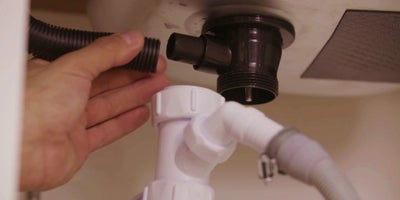Crucial Steps To Fix A Slow-Draining Sink
Crucial Steps To Fix A Slow-Draining Sink
Blog Article
Just about everyone will have their personal assumption in relation to Solved! How to Fix a Slow Sink Drain.

Intro
We've all existed: You're cleaning your teeth or washing your hands, and you see the water pooling in the sink. As opposed to promptly swirling down the drain, it remains, transforming your once-refreshing early morning routine right into a small swamp scene. A slow-draining sink isn't just annoying; it's usually an indicator of bigger plumbing problems lurking underneath the surface area. The bright side is that many slow-draining sinks can be taken care of with a little expertise, a couple of basic tools, and some patience. All set to tackle this job head-on? Allow's roll up our sleeves and dive right in.
Comprehending the Root Causes Of a Slow-Draining Sink
Before you begin poking around in your pipes, it helps to know what might be creating the slowdown. Understanding the root cause makes it simpler to pick the best fix.
Usual Offenders Behind Slow Drainage
So, what's blocking things up? Typically, it's a blend of everyday particles-- assume hair, soap residue, tooth paste residue, and leftover food bits. Over time, these little bits gather and cling to the pipeline walls, progressively narrowing the flow and making it harder for water to pass through. In many cases, mineral deposits from tough water can likewise add to the crud, developing the excellent storm for stubborn blockages.
When is it Time to Act?
If you observe the water draining pipes slower than typical, it's an excellent idea to interfere faster rather than later on. Waiting as well long can cause finish blockages, undesirable odors, or even pipe damage. If the water takes greater than a couple of secs to clear out after shutting off the tap, consider it a red flag and prepare yourself to place on your DIY hat.
Tools and Materials You'll Need
The right tools make all the difference. The good news is, you won't need a fully equipped plumbing's van to get the job done.
Vital Devices for DIY Repair Works
A bettor is your best beginning factor. A small, sink-sized plunger creates suction that can remove small clogs. For even more relentless clogs, a drain serpent (often called a plumbing technician's auger) functions wonders. A pair of gloves, a flashlight, and perhaps a pair of safety safety glasses are additionally handy.
Recommended Cleansing Solutions
Mild meal soap and hot water can assist break down oily accumulation. A combination of cooking soda and vinegar is a time-tested home remedy, and enzymatic cleaners supply a more environment-friendly technique. Keep chemical drain cleansers as a last resource, as they can be harsh on your pipelines.
Security First: Safety Measures and Preparations
Prior to you launch into unclogging mode, think about safety and security. You're dealing with potentially unclean water and debris, so slip on a set of gloves. If you're making use of chemical cleaners, guarantee the room is well-ventilated and comply with the instructions on the tag.
Safety Equipment and Office Configuration
Set some old towels or dustcloths around the sink location to catch splashes. Eliminate any kind of items that could get in your method, like soap dispensers or tooth brush holders. Ensure you have good lighting-- order a flashlight if required.
Step-by-Step Overview to Dealing With a Slow-Draining Sink
Currently, allow's enter the nitty-gritty. This detailed procedure will guide you via simple methods to recover your sink's drainage.
Step 1: Remove and Tidy the Stopper
Commonly, the stopper (that small plug you lower to obstruct water) is the very first wrongdoer. Remove it meticulously and clean off any hair or gunk trapped around its base. Wash it extensively before placing it back in place.
Step 2: Make Use Of a Plunger to Dislodge Particles
Got that bettor all set? Placement it over the drainpipe and offer it a few firm pumps. The idea is to create suction that can loosen any type of obstruction. If you see littles particles floating up, you're on the best track.
Action 3: Attempt a Drain Serpent or Cable Wall Mount
If the bettor doesn't work, it's time to highlight the drainpipe snake. Delicately feed it right into the drain and twist as you go. You could feel some resistance-- that's most likely the clog. Keep twisting and drawing till you remove the obstruction. If you do not have a drain snake, a corrected the alignment of wire wall mount can operate in a pinch.
Tip 4: Apply a DIY Drainpipe Cleaner
An all-natural cleaner made from baking soda and vinegar can break down recurring grime. Put half a mug of baking soft drink into the drainpipe, adhered to by half a mug of vinegar. Let it fizz for around 15 minutes, then flush with warm water. This chain reaction typically does marvels for minor obstructions.
Step 5: Reassemble and Test the Sink
Put whatever back with each other and run the tap. Does the water currently swirl down the tubes at a respectable rate? If yes, offer on your own a pat on the back. Otherwise, do not anguish-- there are still a few even more tricks up your sleeve.
Alternate Techniques for Stubborn Clogs
Not all obstructions are developed equal. If your sink still refuses to cooperate, take into consideration these different services.
Sodium Bicarbonate and Vinegar Technique
We already discussed this, however it deserves keeping in mind once more. This gentle, green method is much safer than chemical cleaners and usually rather effective.
Enzymatic Drain Cleaners
Enzyme-based cleaners make use of natural bacteria to absorb organic matter. They're an exceptional choice if you're wanting to avoid extreme chemicals. Simply keep in mind, they might take a bit longer to work their magic.
Chemical Drainpipe Cleaners: Pros and Cons
Chemical cleaners can blast with difficult blockages quickly, however they're not without drawbacks. They can generate warmth and fumes, damage pipelines if made use of excessively, and posture environmental dangers. Use them moderately, and constantly comply with the directions meticulously.
Safety Nets to Keep Your Sink Flowing
Avoidance is the best treatment. By taking on a couple of basic routines, you can keep your sink from slowing down to begin with.
Normal Cleansing Practices
Wipe down the sink container and component area consistently. Remove hair or food particles prior to they have a possibility to wash down the drain.
Avoiding Hazardous Materials Away
Reconsider before dumping coffee grounds, grease, or fibrous veggie scraps down the sink. These offenders hold on to pipeline walls, creating obstructions over time.
Routine Maintenance Checks
Arrange a quick regular monthly inspection. Run hot water through the sink for a couple of minutes, paying attention to the flow. If it appears slow, act fast before it comes to be a full-blown clog.
When to Call an Expert Plumbing Professional
Often, no matter exactly how tough you try, that obstruct just will not budge. That's when it's time to generate the pros.
Indications That Show an Extra Significant Problem
If your sink drains gradually regardless of numerous attempts, or if you observe water supporting in other components (like your shower or commode), you may have a more major pipes concern lurking much deeper in the system.
Stabilizing DIY Initiatives with Professional Assistance
While DIY can conserve you money and provide a feeling of accomplishment, there's no embarassment in calling a specialist. An expert plumbing technician can examine your entire pipes arrangement, ensuring there's no underlying damages or lasting trouble that could cost you much more in the future.
Comparing Expenses and Long-Term Solutions
Before making a decision, take into consideration the big picture. A low-cost, quick fix may solve the trouble momentarily, yet investing in a much more permanent solution can save you money and stress over time.
Evaluating the Expenses of Do It Yourself vs. Specialist Fixes
DIY solutions usually set you back little bit greater than the price of a bettor or a container of baking soft drink. Specialist services, on the other hand, featured a price however might avoid repeated concerns and pricey repair work later.
Buying Quality Fixtures and Upgrades
If your sink's design adds to constant blockages, it may be worth upgrading to higher-quality fixtures or modifying the pipes layout. Consider this a financial investment in your house's functionality and convenience.
Final thought
A slow-draining sink can feel like a small irritation, yet it's usually an indication that your plumbing requires a little TLC. By understanding the root causes, using the right tools and methods, and dedicating to straightforward safety nets, you can maintain your sink streaming freely. And when all else fails, never be reluctant to contact a professional-- your home's plumbing deserves the financial investment in care and upkeep.
Three Common Ways to Fix a Slow Drain
Baking Soda Method
Boil a full pot of water. Measure out cup of baking soda and pour it down the drain. Then take cup of the magical cleansing substance known as white vinegar and drop that down there too. Allow the mixture to fizz in the drain for five minutes as the vinegar and baking soda combine. Now dump in that whole pot of boiling water. This combination of cleaning substances should clear out anything that is causing your sink to drain slowly. If it doesn t...
Zip-It
If the baking soda method doesn t clear out your drain, it may be because a significant amount of hair and/or other debris has collected there and you need to remove it. Purchase a Zip-It tool at any home improvement or hardware store and insert it into your drain. It will catch any collected hair or debris that s blocking the flow of water. Pull it out. If it s got a big clump of hair, etc. on the end, you ve probably got your culprit.
Drain Cleaner
If these methods don t work, there is the standard drain cleaner that you can also buy in a hardware store or even your local grocery store. It s better if you can use a household solution, but these drain cleaners often work in a pinch. They re very simple to use. You generally just dump them in your drain and wait. If even this method is not effective, it may be time to call the plumber.
https://www.mrrooter.com/oneida/about-us/blog/2017/july/three-common-ways-to-fix-a-slow-drain/

As a passionate person who reads on How to Fix a Slow Draining Sink, I figured sharing that article was a great idea. Are you aware of anybody else who is fascinated with the topic? Please feel free to promote it. Thank you for taking the time to read it.
Click Report this page